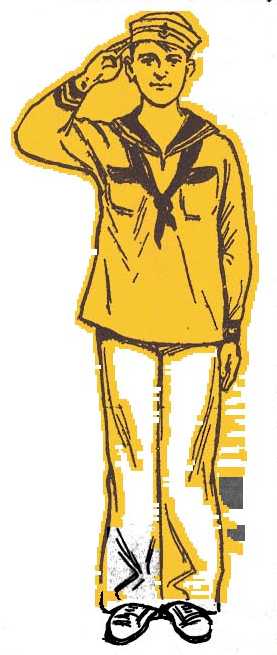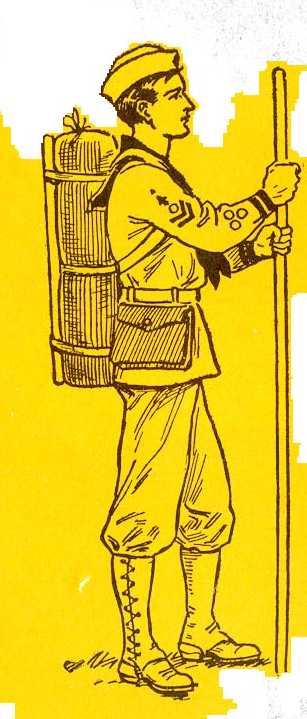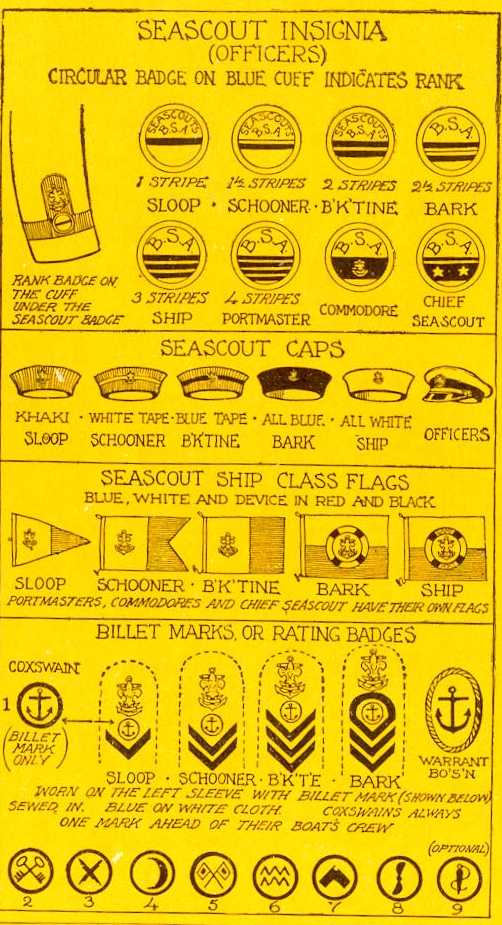


Overview
The early years of the Sea Scout program (or Seascouts as they were
sometimes
called then) is unclear. During this time the program was ever
changing
as different people got involved. Because of this, the
information
about this time is incomplete. We'll try as best to cover it
here.
Lord Baden-Powell's older brother Warrington wrote the first book on Sea Scouts in the UK. This was used in the early days of Sea Scouting in the BSA until others could come up with something.
In 1912, Sea Scouts was officially begun in the BSA when Arthur A Carey of Massachusetts was appointed the Chairman of the National Council Committee on Sea Scouting. He had worked with establishing Sea Scouts using his schooner the Pioneer. Another figure at that time was Charles Longstreth of Philadelphia. He worked with a patrol of Sea Scouts on his yacht. Both men prepared works and Carey's Cruising for Sea Scouts was the first American Sea Scout literature. It was intended to be used as a supplement to the Boy Scout Handbook until a full manual could be produced. Longstreth's work, Nautical Scouting, followed.
Despite the work of these two men, on a National level Sea Scouting struggled without having good leadership or resources available. But it did grow, if slowly.
In 1917, James Austin "Kimo" Wilder came on board. He became
the Chief Seascout (the first and as far as I know, the only one to
hold that title), and served as the (volunteer) Director of the
Department of Sea Scouting. He supervised the preparation of the
first true Sea Scout Manual. The program at this time is
not quite what we think. Requirements to
become a Sea Scout was set to 15 years old and weighting 112 pounds.
James Wilder (1868-1934) was an interesting figure in early scouting
who is today forgotten. He apparently got Scouting going in
Hawaii, wrote several early scouting booklets (The Yucca Patrol Idea
and Pine Tree Patrol Service Lirbrary booklets), and his work with Sea
Scouts.
Despite his work, Wilder was unable to really turn around the program. In 1923, Kimo Wilder agreed to step down, and was replaced by Commander Thomas J. Keane. Keane had become involved with Sea Scouts in the Chicago area, and had done a good job of revitilizing the program there, hence the reason he was asked to takeover the National program. Over the next few years, Keane would revise the Sea Scout program, turning it into the program we know today. Go to the Sea Scouts (1924-49) for information on this.
Program
The program during these years is unclear. It was nautically
based,
but it is unclear what advancement (if any) might have existed for Sea
Scouts
during this time. It appears that Sea Scout units were named
based
on the size of the units.
The Sea Promise(started in 1920)
As a Sea Scout I promise to do my best--
1. To guard against water accidents.
2. To know the location and proper use of the life saving devices on
every
boat I board.
3. To be prepared to render aid to those in need.
4. To seek to preserve the Motto of the Sea, "Women and Children
First."
Uniform
It was under Kimo's tenure that unique Sea Scout uniforms began in
1919. During this time, Sea Scouts did not wear the blue or white
naval style
uniforms
that might be expected. Instead, Sea Scouts wore khaki uniforms
with
navy blue insignia. The jumper, pants, and
leggings
of the uniform shown below were khaki with navy blue collar, pocket
flaps,
and wrist bands. Some works show the insignia used, but it is
unclear
what purpose they had. Below are copies from BSA catalogs at the time
showing
the uniform and insignia. If anyone can explain what they all
mean,
it would be appreciated. Sea Scout Ships were given different
names
based on their size (Sloop, Schooner, etc.), and thus each had their
own
caps. Am unclear what the different officer names signify, nor
the
ratings badges and billet marks.







Advancement Program
It is unclear to me if there was an advancement program for Sea Scouts.
 |
 |
|||
Unit Organization
It is unclear how the Sea Scout units were organized.
Council/National Organization
Literature
During this formulate period of Seascouting, four different works
served as
the Seascout's manual. The first edition is Warrington
Baden-Powell Sea Scout manual developed in England and used here
unchanged.
Until a full, American Sea Scout manual was created, Cruising
for Sea
Scouts was used as a supplement to the Boy Scout Handbook.
This was replaced by the short lived Nautical Scouting.
Finally,
Chief Seascout James Wilder edited a new Seascout Manual.
A good deal of it was written by Fleet Portmaster Herbert G. Horton.
| Sea Scouting and Seamanship for Boys (1st
edition) Warrington Baden-Powell |
 |
| Cruising for Sea Scouts (2nd edition)
1st 1912 2nd 1913 3rd 1914 A.A. Carey, author |
NO PICTURE |
| Nautical Scouting (3rd edition) (#3524)
1915 Charles Longstreth |
 |
| Seascout Manual (4th Edition) 1st 1920 2nd 1922 3rd 1923 4th 1923 5th 1923 J.A. Wilder, ed |
 |
Updated: 01/20/2005mrb